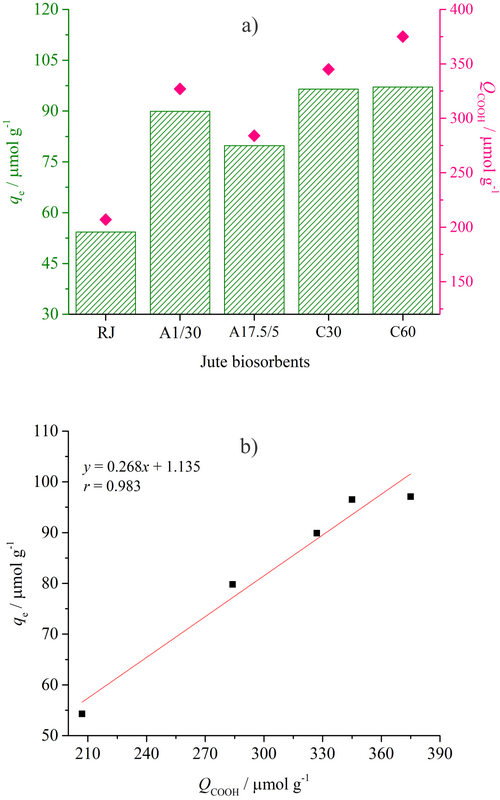Kinetic and isotherm studies for the biosorption of nickel ions by jute fabrics Scientific paper
Main Article Content
Abstract
Raw jute fabric was chemically modified with 1 % NaOH for 30 min, 17.5 % NaOH for 5 min or with 0.7 % NaClO2 for 30 and 60 min to study the influence of changes in the chemical composition of the fabrics and quantity of carboxyl group on the biosorption capacity of the fabrics for nickel ions. The effects of contact time and initial concentration of nickel ions on the biosorption capacity of the fabrics were also investigated. The obtained results revealed that the biosorption of nickel ions can be explained by the pseudo-second-order kinetic model, while the experimental isotherm data fit better with the Langmuir model. The calculated ratios between maximal biosorption capacity (6.30–12.06 mg g-1) of the jute fabrics and carboxyl group quantity indicated that approximately half of the carboxyl groups of the fabrics would be involved in binding nickel ions during biosorption. Therefore, the quantity of carboxyl group can be used to predict the maximal biosorption capacity of jute fabrics toward nickel ions. In the case of oxidized jute fabrics, the lignin removal, and consequently increased content of cellulose and hemicelluloses, also contributed to a higher biosorption capacity.
Downloads
Metrics
Article Details

This work is licensed under a Creative Commons Attribution-NonCommercial-NoDerivatives 4.0 International License.

Authors retain copyright and grant the journal right of first publication with the work simultaneously licensed under a Creative Commons Attribution license 4.0 that allows others to share the work with an acknowledgement of the work's authorship and initial publication in this journal.
References
Z. Kovacova, S. Demcak, M. Balintova, C. Pla, Materials 13 (2020) 3575 (https://doi.org/10.3390/ma13163575)
G. Crini, E. Lichtfouse, Environ. Chem. Lett. 17 (2019) 145 (https://doi.org/10.1007/s10311-018-0785-9)
A. Ivanovska, D. Cerovic, S. Maletic, I. Jankovic Castvan, K. Asanovic, M. Kostic, Cellulose 26 (2019) 5133 (https://doi.org/10.1007/s10570-019-02421-0)
A. Ivanovska, D. Cerovic, N. Tadic, I. Jankovic Castvan, K. Asanovic, M. Kostic, Ind. Crop. Prod. 140 (2019) 111632 (https://doi.org/10.1016/j.indcrop.2019.111632)
A. Ivanovska, M. Kostić, J. Serb. Chem. Soc. 85 (2020) 1621 (https://doi.org/10.2298/JSC201013069I)
W. Ganer, Textile Laboratory Manuel: Fibers, Heywood Books, London, 1967
M. Knežević, A. Kramar, T. Hajnrih, M. Korica, T. Nikolić, A. Žekić, M. Kostić, J. Nat. Fibers (2020), in press (https://doi.org/10.1080/15440478.2020.1745120)
S. Lagergren, Handl. 24 (1898) 1
Y. S. Ho, G. McKay, Process. Biochem. 34 (1999) 451 (https://doi.org/10.1016/S0032-9592(98)00112-5)
A Y.-S. Ho, W.-T. Chiu, C.-C. Wang, Bioresour. Technol. 96 (2005) 1285 (https://doi.org/10.1016/j.biortech.2004.10.021)
K.-Y. Shin, J.-Y. Hong, J. Jang, J. Hazard. Mater. 190 (2011) 36 (https://doi.org/10.1016/j.jhazmat.2010.12.102)
V. Rizzi, F. D'Agostino, P. Fini, P. Semeraro, P. Cosma, Dyes Pigments 140 (2017) 480 (https://doi.org/10.1016/j.dyepig.2017.01.069)
V. Rizzi, F. Romanazzi, J. Gubitosa, P. Fini, R. Romita, A. Agostiano, A. Petrella, P, Cosma, Biomolecules 9 (2019) 571 (https://doi.org/10.3390/biom9100571)
Y. S. Ho, G. Mckay, Water. Res. 34 (2000) 735 (https://doi.org/10.1016/S0043-1354(99)00232-8)
A. Vázquez-Guerrero, R. Cortés-Martínez, R. Alfaro-Cuevas-Villanueva, E. M. Rivera-
-Muñoz, R. Huirache-Acuña, Water 13 (2021) 89 (https://doi.org/10.3390/w13010089)
P. Semeraro, P. Fini, M. DAddabbo, V. Rizzi, P. Cosma, Int. J. Environ. Agric. Biotechnol. 2 (2017) 1835
R. Kumar, R. Kr. Sharma, React. Funct. Polym. 140 (2019) 82 (https://doi.org/10.1016/j.reactfunctpolym.2019.04.014)
S. Loiacono, G. Crini, G. Chanet, M. Raschetti, V. Placet, N. M. Crini, J. Chem. Technol. Biotechnol. 93 (2018) 2592 (https://doi.org/10.1002/jctb.5612)
G. Z. Kyzas, Z. Terzopoulou, V. Nikolaidis, E. Alexopoulou, D. N. Bikiaris, J. Mol. Liq. 209 (2015) 209 (https://doi.org/10.1016/j.molliq.2015.05.060)
C. M. Hasfalina, R. Z. Maryam, C. A. Luquan, M. Rashid, J. Nat. Fibers 7 (2010) 267 (https://doi.org/10.1080/15440478.2010.527508)
P. M. Shukla , S. R. Shukla, Sep. Sci. Technol. 48 (2013) 421 (https://doi.org/10.1080/01496395.2012.691933)
S. R. Shukla, R. S. Pai, A. D. Skendarkar, Sep. Purif. Technol. 47 (2006) 147 (https://doi.org/10.1016/j.seppur.2005.06.014)
H. Parab, S. Joshi, N. Shenoy, A. Lali, U. S. Sarma, M. Sudersanan, Process. Biochem. 41 (2006) 609 (https://doi.org/10.1016/j.procbio.2005.08.006)
K. Swarnalatha, S. Ayoob, Int. J. Sust. Technol. 9 (2016) 259 (https://doi.org/10.1080/19397038.2016.1152323)
Ch. Aravind, K. Chanakya, K. Mahindra, Int. J. Civil Eng. Technol. 8 (2017) 1869 (http://www.iaeme.com/MasterAdmin/uploadfolder/IJCIET_08_04_213/IJCIET_08_04_213.pdf)
D. Nityanandi, C. V. Subbhuraam, K. Kadirvelu, Environ. Technol. 27 (2006) 15 (https://doi.org/10.1080/09593332708618621)
D. Q. Melo, C. B. Vidal, A. L. da Silva, G. S. C. Raulino, A. D. de Luz, C. da Luz, P. B. A. Fechine, S. E. Mazzeto, R. F. do Nascimento, Int. J. Civil Environ. Eng. 15 (2015) 14 (http://ijens.org/Vol_15_I_06/155505-1506-2929-IJCEE-IJENS.pdf)
S. R. Shukla, R. S. Pai, Bioresource Technol. 96 (2005) 1430 (https://doi.org/10.1016/j.biortech.2004.12.010).





